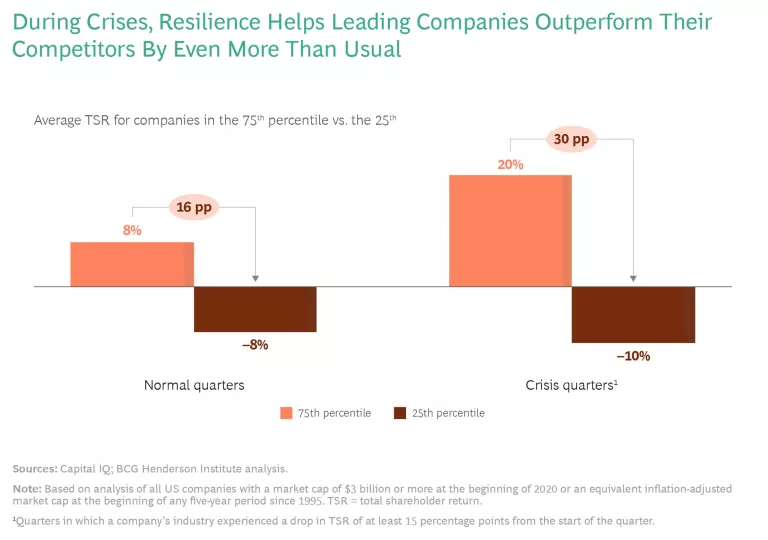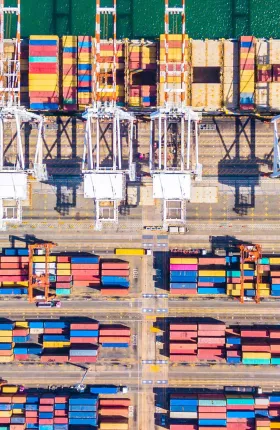The COVID-19 crisis has been a wake-up call for supply chain managers. For years, companies have focused on eliminating redundancy in sourcing to reduce fixed costs and promote efficiency. Greater efficiency, however, came at the expense of diminished flexibility and effectiveness—a tradeoff the pandemic-induced supply chain disruptions have made painfully clear.
Now, leading companies are seeking to avoid that tradeoff, using innovative capabilities such as risk-focused analytics engines, simulation, and end-to-end transparency to design supply chains that are both cost effective and resilient. It’s a difficult balance to achieve, one that requires a thoughtful analysis of scenarios and economics to ensure that additional costs are rewarded with reduced risk. But the benefits of a resilient supply chain can be enormous—adding significant value in normal environments as well as during major disruptions.
Supply Chains Face Unprecedented Challenges
In recent years, the conventional wisdom has been that companies should prioritize efficiency over redundancy in their supply chains. This meant, for example, consolidating volumes with suppliers to drive down unit costs and implementing “just in time” sourcing models to reduce inventory levels.
The downside of this approach was evident even before the pandemic, as companies faced milder disruptions arising from, for example, higher tariffs and more stringent regulations. In those cases, supply chain performance was hampered by insufficient spare capacity and inventory buffers as well as over-reliance on sole suppliers.
Then came the COVID-19 crisis, which has created unprecedented stress on global supply chains. Companies have encountered massive uncertainty over demand, long delays from suppliers and logistics partners, and operations stoppages caused by unavailability of resources.
As the global economy emerges from the pandemic, supply chains will continue to face a number of severe challenges:
- Product portfolios and offerings have exploded in size and diversity
- Production and supply networks have become increasingly complex
- External pressures, including regulations and trade barriers, have intensified
- Customer segments have become more volatile, with rising service requirements
- Multiple stakeholders are demanding action to promote sustainability
In the face of such challenges, many companies struggle to optimize supply chains from end to end, leading to major impact on value delivery. To address these issues, companies need to become more resilient without sacrificing cost effectiveness.
Resilient Companies Outperform
Resilience—the capacity to absorb stress, recover critical functionality, and thrive in altered circumstances—has become a key element in a company’s overall health. Resilient companies enjoy better outcomes than their peers in three ways: the immediate impact of an external shock on their performance can be lower, the speed of their recovery can be faster, and the extent of their recovery can be higher.
And resilience translates into value, as our analysis shows. We studied the performance of approximately 1,800 US companies from 1995 to 2020, assessing their resilience by measuring the relative total shareholder return (TSR) of each company as compared with the average of its industry during crisis quarters—quarters in which that industry’s TSR saw a peak decline of at least 15 percentage points from the start of the quarter.
In any given industry, resilience has helped leading companies outperform their peers in terms of TSR by even more than usual during crises. (See Exhibit 1.) In stable quarters, the average gap in TSR between the 75th and 25th percentile performers in an industry is 16 percentage points. However, this nearly doubles to 30 percentage points in crisis quarters. The bottom line: the ability to perform well during crises, as enabled by resilience, has an outsized impact on shareholder return.

Six Pillars of Supply Chain Resilience
A resilien t s upply chain allows companies to be responsive to customer needs and maintain high service levels while also keeping net working capital and costs under control. To strike that balance and capture the benefits, companies can leverage our six pillars of supply chain resilience —three that allow companies to better absorb shocks, and three that help them react faster when disruptions occur.
Increasing the Ability to Absorb Shocks
Resilient companies absorb shocks in day-to-day, end-to-end supply chain operations more effectively by using buffers and strategic inventory. In the event of major disruptions, they minimize the risk of a complete network shutdown and other severe impacts by, for example, flexibly switching from primary material flow paths to secondary ones (rebalancing supply around the world) and/or changing suppliers.
Three pillars should support a company’s efforts to absorb shocks: redesigning the global network, setting new parameters for supply chain buffers, and proactively managing suppliers.
Redesigning the Global Network. A resilient network for supply, manufacturing, and distribution achieves flexibility through selective applications of redundancy, such as dual sourcing. Other approaches include nearshoring to reduce dependence on complex global logistics and vertical integration to bring manufacturing for critical components (including those that are IT related) in house. A comprehensive risk assessment can provide the basis for determining how to balance flexibility, efficiency, and effectiveness when redesigning a global network. (See the sidebar, “An Auto Parts Supplier Diversifies Its Global Network.”)
An Auto Parts Supplier Diversifies Its Global Network
To inform efforts to diversify its network globally, the company conducted a comprehensive risk assessment of its supply chain across all product categories. This entailed a structured three-step approach for each sourcing category:
- Risk Assessment and Hypothesis. The company baselined the current supply chain, assessed global risk exposure, and shortlisted new countries to consider for sourcing.
- Strategy Formulation. To help the company evaluate new supply sources, balanced criteria were defined—including traditional measures such as cost and supply reliability, as well as risk assessments related to geopolitics, financial solvency, and resiliency.
- Execution Roadmap. The company built an implementation plan that specified the resources required and the value delivered. It quantified the financial impacts, where feasible—including the investment required—and integrated the financial impact into the overall evaluation of risk and resiliency.
Setting New Parameters for Supply Chain Buffers. To promote resilience, a company needs to develop an effective multi-echelon inventory strategy, which typically leads to new inventory targets in the supply chain’s high-volatility nodes. In addition, companies should evaluate resetting their capacity utilization targets and identify triggers that signal when to add capacity or activate ready-to-use capacity based on utilization trends. It is also essential to align order fulfillment strategies (whether “make to order” or “make to stock”) to customer needs.
Proactively Managing Suppliers. Resilient companies assess the criticality of suppliers and adjust supplier relationships to ensure resource availability. They also gain transparency into multiple tiers of suppliers so that they can fully assess upstream risks. To gain visibility into the reliability of suppliers, they monitor traditional KPIs such as “on time, in full” and other risk KPIs such as credit ratings and geographic concentration. They also require suppliers to share relevant information on a periodic basis.
One automotive company created a dynamic risk dashboard that aggregates and categorizes internal information and supplier data to provide a comprehensive view of risks. The company also integrates external information from market research or social media analysis into the risk assessments. It has embedded the dashboards into its digital systems and normal supplier-management process; the better understanding of risks enables the company to achieve higher rates for on-time delivery and quality and to avoid significant costs.
Reacting Faster When Disruption Occurs
To quickly react and adjust to disruptions as well as normal volatility, resilient companies apply agile , silo-breaking ways of working across different functions and regions. They manage routine deviations through transparency and develop a forward-looking view on risks and opportunities through simulation. They also use robust processes and analytical tools to react quickly to routine volatility and small disruptions. When major disruptions occur, their rapid response is enabled by effective processes, a clear understanding of the impact on material flows, and full system control.
Three pillars should support a company’s rapid-reaction capabilities: managing the multienterprise supply chain; actively managing end-to-end risk; and planning based on anticipation, simulation, and scenarios.
Managing the Multienterprise Supply Chain. Resilient companies recognize that the constraint on responding to unforeseen events often does not lie in their own assets, but in those of the third parties that support their end-to-end supply chain. To accelerate action, they gain end-to-end transparency and enable collaboration, including outside their “four walls.” (See the sidebar, “A Medical Device Company Invests in Actionable Visibility.”)
A Medical Device Company Invests in Actionable Visibility
The company quickly established a digital tool that translates production plans into sourcing requirements for parts. It also asked tier one suppliers to provide SKU-level weekly production plans for the next four months and fed this data into the digital tool. By matching the suppliers’ production plans against the sourcing requirements, the manufacturer can pinpoint which critical parts might constrain production. It then collaborates with the suppliers of these parts to maximize their availability. Weekly updates of the analysis allow the company to reset its priorities as needed.
The company set up a similar tool that gives visibility into tier two supply availability while monitoring tier one suppliers’ ability to remove constraints in their assembly plans. It also created a linear program to optimize the allocation of constrained materials across product models based on the profitability and strategic importance of customer orders.
The data these new tools collected or produced was consolidated into the company’s existing data lake, feeding into dashboards that enable decision making and guide day-to-day priorities. In addition, the company’s existing cloud infrastructure hosts the digital solution that processes data from suppliers and develops visualizations and recommendations. With these tools and processes in place, the company was able to increase its volume output by 600% in eight weeks. It also identified a path to achieving a twelvefold volume improvement in six months.
This visibility includes not only suppliers across multiple tiers, but also logistic providers and distribution channels. Resilient companies apply insights from analytic engines powered by artificial intelligence to support adaptive decision making, and they coordinate within their internal and external operations to improve end-to-end performance. They also deploy sales and operations execution practices across the end-to-end supply chain to adapt to changes in supply and demand, thereby augmenting their plans that cover monthly time horizons or longer. Their ability to rapidly assess different scenarios allows them to react faster and more effectively.
Actively Managing End-to-End Risk. Comprehensive risk monitoring of suppliers, regions, finances, and cyber security provides companies with an early warning system. Companies gather new data sources that monitor external risk indicators, such as weather forecasts, potential social unrest, trade policy shifts, and financial markets, and combine them with traditional operational data (such as lead times, inventory levels, and order volume) in a central repository. To develop leading indicators of supply chain risk, the company feeds the data into risk-focused analytics engines powered by AI.
Resilient companies use the intelligence generated to get a head start on designing and prioritizing mitigation actions. They also create risk committees to oversee mitigation and develop business continuity plans to prepare for disruptions.
Planning Based on Anticipation, Simulation, and Scenarios. By deploying advanced solutions, such as digital twins , companies can significantly improve their ability to address crises as well as cope with day-to-day volatility. Digital twins simulate the performance of the entire supply chain system weeks in advance and use “smart” alerts to pinpoint which customers and consumers are likely to be affected by disruptions.
A company can use these insights to identify early mitigation actions to address break points. It can also apply scenario-based planning to understand the impact of multiple potential risks. Companies are thereby able to balance risks with requirements for service and inventory, as well as understand the impact of risks well in advance. This capability allows them to avoid the tradeoffs between resilience, efficiency, and effectiveness to deliver benefits on all fronts.
We have seen companies in process industries and the oil and gas industry, for example, use digital twins to enhance their ability not only to deal with pandemic-induced disruptions but also to achieve valuable benefits in any market environment. The benefits include EBITDA improvements of 1 to 3 percentage points, inventory reductions of 5%, and reductions in capital expenditures of up to 10%.
As a prerequisite to defining new resilience strategies, companies need to better understand their exposure, vulnerabilities, and potential losses. These insights will help them pinpoint where redundancies and buffers are most likely to yield benefits that justify the costs. Companies that succeed in establishing real-world resilience will be rewarded with smoother supply operations in the face of both normal volatility and severe disruptions.












